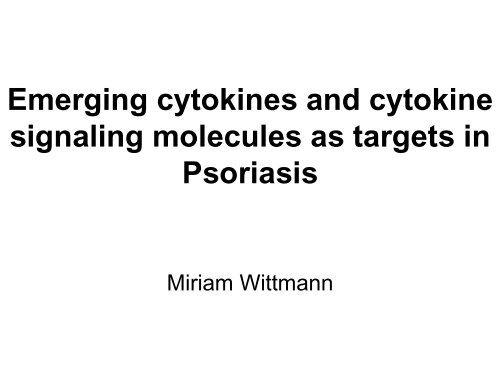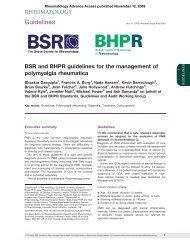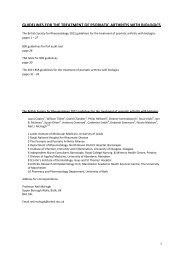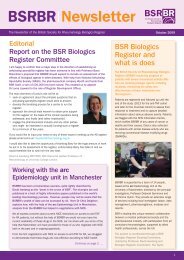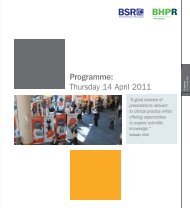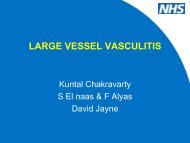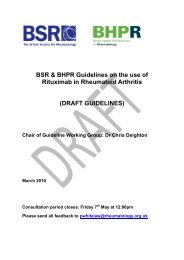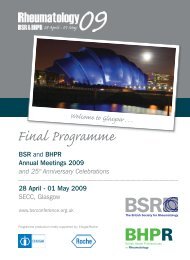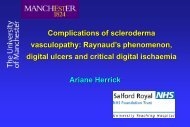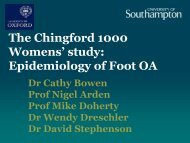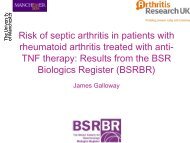Emerging cytokines and cytokine signalling molecules as ...
Emerging cytokines and cytokine signalling molecules as ...
Emerging cytokines and cytokine signalling molecules as ...
You also want an ePaper? Increase the reach of your titles
YUMPU automatically turns print PDFs into web optimized ePapers that Google loves.
<strong>Emerging</strong> <strong><strong>cytokine</strong>s</strong> <strong>and</strong> <strong>cytokine</strong><br />
signaling <strong>molecules</strong> <strong>as</strong> targets in<br />
Psori<strong>as</strong>is<br />
Miriam Wittmann
• Regulation of Inflammation<br />
• Cytokine network in Psoriatic Inflammation<br />
• Mechanical Stress <strong>and</strong> Cytokines<br />
• Kin<strong>as</strong>e Inhibitors<br />
• Outlook
Regulation of immune responses<br />
pro-inflammatory „immune response“<br />
trigger<br />
Inflammation<br />
Resolution<br />
time
Regulation of immune responses<br />
pro-inflammatory „immune response“<br />
trigger<br />
Inflammation<br />
Resolution<br />
1. Persistence of trigger<br />
2. Dysregulated cell activation /<br />
positive feedback<br />
mechanisms<br />
3. Lack of counter-regulatory<br />
pathways<br />
time
Tissue cells<br />
Chemokines:<br />
MCP-1<br />
IL-8<br />
CCL20<br />
Tissue cells<br />
VEGF<br />
IL-1<br />
TNF<br />
IL-6<br />
DAMPs
Koebner phenomenon
McGonagle D, JEADV 2009
Tenocytes<br />
Schulze-Tanzil et al.
Anti-<strong>cytokine</strong> therapies developed for psori<strong>as</strong>is<br />
CT637<br />
HMGB1-RAGE interaction<br />
Generic name<br />
Cytokine Target<br />
Etanercept, Infliximab, Adalimumab TNF<br />
Ustekinumab<br />
Briakinumab<br />
------<br />
Secukinumab<br />
Brodalumab<br />
Ixekizumab<br />
CNTO1959<br />
SCH900222<br />
Fezakinumab (ILV-094)<br />
NN8226<br />
IL12/23 p40<br />
IL12/23 p40 (withdrawn)<br />
IL-17<br />
IL-17<br />
IL-17<br />
IL-23p19<br />
IL-23p19<br />
IL-22<br />
IL-20<br />
AMG 714<br />
IL-15<br />
ABX-IL8 IL-8 (modest results in ph<strong>as</strong>e 2,<br />
MEDI 545<br />
discontinued for psori<strong>as</strong>is)<br />
IFNalpha (ph<strong>as</strong>e 1 completed, no<br />
clinical activity in established dise<strong>as</strong>e)
Tissue cells<br />
Chemokines:<br />
MCP-1<br />
IL-8<br />
CCL20<br />
Tissue cells<br />
VEGF<br />
IL-1<br />
TNF<br />
IL-6<br />
DAMPs
IL-12/IL-23p40<br />
Bell et al, Nat Rev Rheumatol, 2011
IL-17 <strong>and</strong> TNF act synergistically<br />
+ Stromal cells<br />
MMPs<br />
Chiricozzi, J Invest Dermatol, 2011
IL-17 <strong>and</strong> TNF act synergistically<br />
+ Stromal cells<br />
MMPs<br />
Chiricozzi, J Invest Dermatol, 2011
Mechanical Stress <strong>and</strong> Cytokines<br />
IL-36
IL-17 stimulates Psori<strong>as</strong>is-Keratinocytes to express<br />
IL-1F9 (= IL-36)<br />
IL-1F6 (fold induction)<br />
4h<br />
24h<br />
4h<br />
24h<br />
4h<br />
24h<br />
4h<br />
24h<br />
IL-1F9 (fold induction)<br />
IL-36α<br />
100<br />
*<br />
*<br />
*<br />
15<br />
IL-36<br />
80<br />
60<br />
10<br />
40<br />
IL-1F6<br />
IL-1F9<br />
5<br />
20<br />
0<br />
0<br />
healthy<br />
pso<br />
healthy<br />
pso<br />
Muhr et al, Br J Dermatol, 2011
Tenocytes express IL-1F9<br />
Relative IL-1F9 mRNA levels (normalised to U6)<br />
30<br />
20<br />
10<br />
0<br />
NS<br />
IL-1alpha 1ng/ml<br />
IL-1alpha 10ng/ml<br />
IL-1alpha 100ng/ml<br />
Dermal fibrobl<strong>as</strong>ts Tendon fibrobl<strong>as</strong>ts
IL-1F9 protein expression in kertinocytes is<br />
induced by shear stress<br />
No stress<br />
No<br />
serum<br />
with<br />
serum<br />
Shear stress<br />
No<br />
serum<br />
with<br />
serum<br />
IL-1F9<br />
GAPDH
Incubation of full length IL-1F9 with Supernatant from<br />
stimulated neutrophils incre<strong>as</strong>es pro-inflammatory <strong>cytokine</strong><br />
production<br />
IL-6 (pg/ml)<br />
Full length F9 incubated with<br />
SN from activated neutrophils<br />
3000<br />
5min<br />
15min<br />
2000<br />
IL-8<br />
1000<br />
0<br />
ns<br />
NSN<br />
IL-1F9 + NSN<br />
IL-1F9 (100ng/ml)<br />
TNFa (10ng/ml)<br />
TNFa + F9<br />
TNFa + F9 + NSN<br />
• Isolated neutrophils activated with zymosan<br />
• SN incubated 15 min with full length F9<br />
• added to cells
IL-36<br />
Schulze-Tanzil et al.
Kin<strong>as</strong>e Inhibitors<br />
• Protein kin<strong>as</strong>es (= phosphotransfer<strong>as</strong>es) are<br />
components of signaling pathways<br />
• Several Janus kin<strong>as</strong>e inhibitors are being<br />
tested in clinical trials for autoimmune<br />
dise<strong>as</strong>es<br />
• Jak family consits of 4 members: Jak1, Jak2,<br />
Jak3 <strong>and</strong> Tyk2
Cytokine receptors signal directly by activating kin<strong>as</strong>es<br />
Cytokines that use type I <strong>and</strong> II <strong>cytokine</strong> receptors signal via the activation of<br />
receptor-<strong>as</strong>sociated Janus kin<strong>as</strong>es (Jaks)<br />
Approx. 60 which<br />
bind to type I/II R<br />
(IFNs, ILs, CSFs<br />
etc)<br />
Jaks are essential<br />
for signaling<br />
Quint<strong>as</strong>-Cardama, Nat Rev Drug Discovery 2011
Kontzi<strong>as</strong> et al, F1000<br />
Reports, 2012
Highly selective kin<strong>as</strong>e inhibitors have been disappointing in the treatment of<br />
autoimmune dise<strong>as</strong>es either due to toxicity <strong>and</strong>/or lack of efficacy
SOCS: Silencer of Cytokine Signaling<br />
Yoshimura et al. Nat Reviews Immunol 2007
Outlook<br />
• microRNA<br />
• Epigenetic
Hannover<br />
• Thom<strong>as</strong> Werfel<br />
• Philipp Muhr<br />
• Jana Zeitvogel<br />
• Julius Renne<br />
Leeds (Faculty of Biological Sciences)<br />
• Rosie Doble<br />
• Adenowola Al<strong>as</strong>e<br />
• Martin Stacey<br />
DFG grant SFB566/A6<br />
Leeds Foundation for<br />
Dermatological Research<br />
Leeds<br />
• Dennis McGonagle (Rheumatology)<br />
• Mark Goodfield (Dermatology)<br />
The Royal Society


